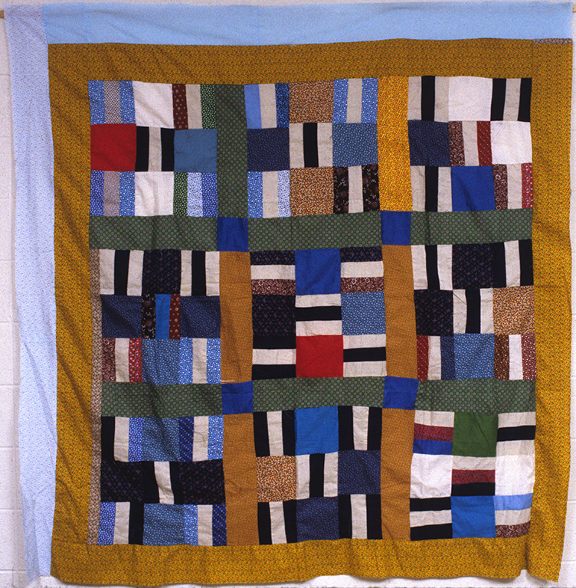Black History Month: Gee's Bend Quilter
African American artists have had a tremendous influence on the miscellaneous arts in America since before the Civil War (1861–1865). The women of the Gee’s Bend community in Alabama have been producing quilts since the late 1800s. Fiber artist Plummer T. Pettway was part of this vibrant quilting community, known as the Gee’s Bend Quilters.
 |
| Plummer T. Pettway (1918–1993, U.S.), Nine-Patch Quilt. Fabric, 76" x 74 13/16" (193 x 190 cm). Courtesy of the Maude Wahlman Collection, Kansas City, Missouri. © 2024 Gee’s Bend Quilters/Artists Rights Society (ARS), New York. (8S-28760gbgars) |
The earliest nine-patch quilts in America date to the early 1800s. It is one of the simplest quilt designs, incorporating nine square blocks of equal size. Each block is composed of small pieces of various materials sewn together. By the 1850s, nine-patch quilts were considered a good way to teach children how to sew. The pattern became increasingly popular during the Civil War. Households in the North and the South had to be frugal due to the shortage of material, using fabric scraps or taking apart worn-out clothing to make quilts. The repurposing of readily available materials appealed to emancipated African Americans as well as pioneer women in the West.
Located in a remote area along the Alabama River, the community of Gee’s Bend formed after the Civil War when formerly enslaved people of the Gees Bend plantation became sharecroppers. During Great Depression (1929–1940), Gee’s Bend Farms, Inc. was a Federal government pilot program to allot former plantation land to Black families in Gee’s Bend and ensure that their culture survived. Little and Martha Jane Pettway (1898–2003), outspoken civil rights leaders of the Gee’s Bend families, encouraged the community to accept the government’s project.
The Gee’s Bend Farms project helped to carry forward traditional fiber arts from Africa, enslaved people, and American and African American vernacular (functional, regional) aesthetic. Three and sometimes four generations of women in the same families have produced quilts in Gee’s Bend. The majority of quilts display geometric simplicity based in the history of women using found textile scraps for their designs. In 2003, more than fifty women from the community formed the Gee's Bend Quilters Collective to serve as a marketing entity for their unique art form.
The tradition of quilt making is carried on by many descendants of formerly enslaved people from the Pettway plantation in Gee’s Bend. Plummer T. Pettway was the oldest daughter of Little and Martha Jane Pettway. Like her mother, she produced quilts for almost sixty years. Pettway was active in many quilting groups in her community and also produced quilts for individuals. In addition to quilting, Pettway raised six children and farmed. Her cousin, Bettie Bendolph Seltzer, summed up her life in this way: "So that was her life, the fields and making quilts. She loved to quilt.” (Souls Grown Deep, Paul and William Arnett editors, Tinwood Media, Atlanta, 2000)
Until the 1900s in the West, folk arts—such as the miscellaneous arts of textiles, woodwork, metalwork, and ceramics—were denigrated as unsophisticated because they were considered the work of untrained, rural people. This included the work of itinerant painters and sculptors who did not seek professional training in their chosen art forms. Folk art ascended in appreciation in the first quarter of the 1900s. At this time, artists interested in modernism showed a conscious effort toward a bold, instinctive sense of design and color that seemed effortless for folk artists.
This design sensibility was especially true about fiber arts, specifically quilts. The two main types of quilts are appliqué (shapes cut out of whole cloth and sewn onto a background fabric) and pieced (pieces sewn together side-by-side). Once considered haphazard arrangements of cloth scraps, quilts gained recognition as works of art in the 1900s when the range of aesthetic expression was examined. Quilts can display dazzling, abstract effects anticipatory of Op Art or the most detailed realism of embroidery.
Correlations to Davis programs: Explorations in Art 2E Kindergarten: 1.4; Explorations in Art 2E Grade 1: 5.6; Explorations in Art 2E Grade 4: 5.1; Explorations in Art 2E Grade 5: 2.4; A Global Pursuit 2E: 5.1, 6.6


Comments